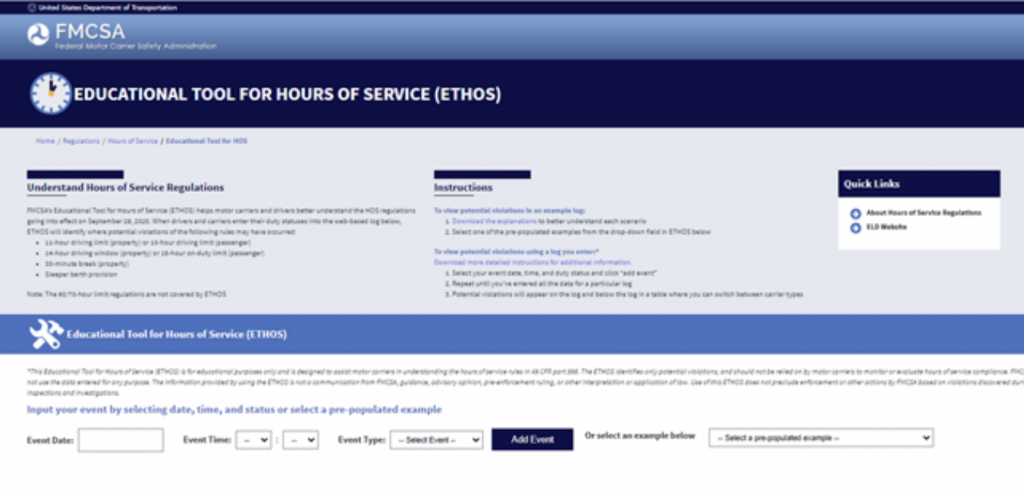FMCSA’s Hours of Service regulation changes has been published and the following information provides guidance on the hours service rules that are applicable through September 28, 2020 and effects due to the changes. Starting from yesterday, the revised provisions of the HOS final rule, published on June 1, 2020, took effect at 12 a.m. eastern time on Sept. 29.
What changed?
The four key changes to HOS regulations are outlined below;
| HOS Provision | Past HOS Rule | New HOS Rule | Impacts |
|---|---|---|---|
| CMV Short-Haul Exemption | Drivers using the short-haul exception may not be on-duty more than 23 hours and may not drive beyond a 100 air-mile radius. | Extends the maximum duty period allowed under the short-haul exception to 14 hours and to 150 air miles. | Improves safety and flexibility by increasing the number of drivers able to take advantage of the short-haul exception. |
| Adverse Driving Conditions | A driver may drive for not more than 2 additional hours beyond the maximum time allowed. However, this does not currently extend the maximum “driving window”. | Allows a driver to extend the maximum “driving window’ by up to 2 hours during adverse driving conditions. | Improves safety and flexibility by allowing drivers time to park and wait out the adverse condition or to drive slowly through it – which has the potential to decrease crash risk. |
| 30 Minute Break | If more than 8 consecutive hours have passed since the last off-duty (or sleeper berth) period of at least half an hour, a driver must take an off-duty break of at least 30 minutes before driving. | Required a 30-minute break after 8 hours of driving time (instead of on-duty time) and allows on-duty / not driving periods to qualify as breaks. | Improves safety and flexibility for drivers by increasing on-duty / non-driving time by up to 30minutes – allowing drivers to reach their destination easier. |
| Split-Sleeper Berth | A driver can use the sleeper berth for an 8/2 split-8 hours of rest that does not count against the 14-hour limit, and 2 hours of rest that does count against the 14-hour driving window. | Modifies the sleeper –berth exception to allow drivers to split their required 10 hours off duty into two periods: an 8/2 split, and a 7/3 split-with neither period counting against the driver’s 14-hour driving window. | Improves safety and flexibility for drivers by potentially increasing the use of sleeper berths because drivers using a berth have additional hours to complete 11 hours of driving. |
HOS Final Rule Fact Sheets issued by FMCSA
What about ELD?
Electronic logging device (ELD) is used to electronically keep a driver’s Record of Duty Status (RODS) and all drivers are required to use an ELD to document their compliance with HOS rules.
In USA
The FMCSA’s final ELD rule was published in December 2015. Considering that today the mandate applies to over three million drivers on the road, it’s important that the trucking industry as a whole is up-to-speed on its ELD facts.
By December 2017, all CDL drivers required to keep a Record of Duty Status (RODS) must use an ELD to document their compliance with HOS rules. The new ELD rule adds certain technical and performance specifications that define exactly what the device must feature to enable professional truck drivers and commercial motor carriers to easily track Hours of Service (HOS) compliance.
In Canada
On April 11, 2019 the CCMTA published the formal Canadian ELD rule. ELD Mandate in Canada comes into effect on June 21, 2021. The Canadian ELD standard is very similar to the USA based FMCSA. The biggest difference is third party certification which ensures all ELD providers are compliant, their service works and meets all criteria.
What is the effective date?
In USA, it’s been already mandated since December 2019. However, in Canada, ELD mandate will be rolled out on June 2021.

How it works
ELD is based on a smartphone app which connects to the Bluetooth-enabled CANbus reader or a GPS device and accepts RPM, odometer, VIN and other data directly from the truck on-board computer.
The ELD app permanently displays the remaining time of “on-duty” and “driving” status, so that drivers can always be in full control and ensure compliance. Drivers can quickly generate electronic logbook right on the mobile device and display in case of a roadside inspection.
Office workers who Manage compliance can then get access to the HOS web app and monitor all drivers’ actual statuses. Easily allowing the back office to clearly see if anybody is out of compliance or close to violating the rules and take appropriate measures.
ELD Benefits
- Increases safety
- Reduced vehicle accidents
- Reduces Costs
- Saves time
- Put hours back in your employee’s day
- Eliminate human error
- Proactive central management
ELD Solutions
Contact us today for more information, pricing, and specific case studies.
Tel: 1-800-964-4551
Email: info@lvmtech.com





